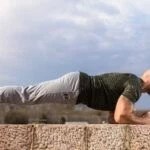Bertolotti syndrome might not be a usual suspect in lower back pain, but diagnostic detective work may uncover this common congenital condition. In fact, Bertolotti syndrome affects approximately 1 in 3,000 people in the United States; about 1 in 10 of those people are over the age of 60 and may experience chronic lower back pain as part of their symptoms. In this article, you will learn how Bertolotti syndrome can present as lower back pain, how it should be diagnosed, types, best exercises, yoga with diet and exercises should be avoid if you suffering from this syndrome.
What is Bertolotti Syndrome?
Bertolotti syndrome was first diagnosed by Dr. Mario Bertolotti in 1917. It is a congenital condition that is a common cause of lower back pain. The condition is caused by a malformation of the lumbar spine.

The malformation can cause the vertebrae to fuse together, which can lead to pain and stiffness in the lower back.
In simple word most individuals are born with five lumbar vertebrae, which are located at the base of the spinal cord.
These vertebrates are dynamic – unattached by the sacrum. However in individuals with Bertolotti syndrome, the L5 lumbar vertebrae—closest to the sacrum—actually fuse with sacrum, putting more stress on other lumbar vertebrae and causing pain.
Exercise is often recommended as a treatment for Bertolotti syndrome, as it can help to strengthen the muscles around the spine and ease pain.
Bertolotti syndrome types.
There are 4 types of Bertolotti syndrome. These are;

- Type I is simply an increased L5 transverse process that is not considered clinically significant.
- Type II involves the increased transverse process and the formation of a unilateral or bilateral diarthrodial joint between the sacrum.
- Type III is a solid fusion either unilaterally or bilaterally.
- Type IV is mixed with 2 pseudoarthrosis on one side.
What Causes It?
Bertolotti syndrome is a condition that affects the spine. However, such condition is congenital, that means it is present at birth.
The syndrome is caused by a malformation of the vertebrae, resulting in the vertebrae not growing properly. This can cause the vertebrae to fuse together, which can lead to pain and stiffness in the lower back.
What Are The Symptoms?
Most people would never know that they had a sanctification or pseudo-joint unless it was accidentally found for something unrelated during an X-ray.
But for cases that cause symptoms, they can vary greatly from person to person and will usually show up in adulthood — in your 20s or 30s.
Symptoms may include:
- Localized low back pain with possible leg pain that does not run down a nerve (this pain is referred to instead of radicular).
- Pain or discomfort in the area of the sacroiliac joint.
- Difficulty walking in certain ways with unexplained stiffness or pain.
- Sitting and lying down improves symptoms.
How Is Bertolotti Syndrome Diagnosed?
Bertolotti syndrome can be diagnosed on the basis of a good medical history, thorough physical examination, and X-ray.
Physical examination will involve recreating movements that trigger pain or discomfort. Then, X-ray of the lower back and pelvis can reveal any bony anatomical abnormalities. This is Bertolotti syndrome when the pseudo joint is pain-causing.
How Is Bertolotti Syndrome Treated?
In most situations, Bertolotti syndrome is effectively managed with non or minimally invasive therapies. These may include;
- Prolotherapy, an alternative treatment that uses a combination of concentrated local anesthetic and dextrose that is injected into the affected area to potentially enhance the body’s natural healing capacity.
- Local anesthetic and occasional corticosteroid injections with affected nerves under fluoroscopic guidance or directly in the pseudo joint to reduce inflammation. Fluoroscopy may also be used for diagnosis.
- Lifestyle changes to reduce stress on the affected parts of the spine such as repetitive rotations and extensions.
- Physical therapy to help create certain areas and potentially increase mobility.
- Platelet-rich plasma (PRP) therapy that uses body platelets to reduce pain and inflammation and healing in damaged joints through injection with fluoroscopic guidance. It avoids the negative effects of corticosteroids such as raising blood sugar levels and reducing treatment. However, these treatments for Bertolotti syndrome have not been well studied and are not covered by insurance.
- Over the counter (OTC) pain medication, such as Tylenol®, Aleve® and Advil®.
- Radiofrequency ablation, a technique that uses heat to deactivate affected nerves around the pseudo joint. This treatment has not been well validated in the treatment of Bertolotti syndrome and requires that the patient get pain relief for some time with anesthetic injections.
Best Exercises for Bertolotti Syndrome.
Following are some different exercises that can be helpful for people with Bertolotti syndrome. However your doctor or physical therapist may also prescribe specific stretches or strength training exercises for this condition.
1. Stretching and Aerobic Exercise.
Stretching and aerobic exercise are an important part of lumbar stabilization physical therapy.
Flexibility is the key to successful lumbar stabilization training, as flexibility allows muscles to easily assume a neutral position.

Cardiovascular (aerobic) conditioning is an important part of the body’s total muscle strength and endurance. It should be combined with the lumbar spine stabilization program.
Maintaining a neutral spine during aerobic exercise is for the more advanced patient and it will not impact the treatment.
2. Hamstring Stretch.

A passive exercise using less muscle effort. Lie down on the floor with knees bent and feet on the floor. Find the position of the neutral spine and maintain it while slowly straightening one leg and lifting the heel towards the ceiling while supporting the back of the thigh with both hands. Pause for 10 to 30 seconds and repeat with the other leg. 3 repetition recommended.
Leg muscles can also be stabilized by using a wall to straighten the leg while relaxing the leg muscles.
3. Lifting Hands/Feet.
A more dynamic exercise is to challenge the neutral spine with arms and/or legs.
Lie on one side with the lower arm bent under the head and rest by placing the hand on the floor near the upper arm chest.

Keep both knees and flex hips and get a neutral spine position. Slowly lift the upper leg 8 to 10 inches further down. Repeat 5 to 10 and repeat in the opposite direction.
4. Pelvic Tilt.
An active exercise from a position where the abdominal muscles are separated and used to move the spine.
Bend on the floor with knees bent and feet flat on the floor. Tighten the abdominal muscles and pull the lower back to the floor. Pause for 10 seconds. Repeat 3 to 5.
5. Ball Bridge Exercise.

An advanced stabilization exercise that introduces unexpected motion that must be responded to ball movement.
Lie down on the floor with both legs straight on the exercise ball and keep the legs straight and relax the arms.
Locate the neutral spine position and hold the buttock muscles slowly tightening to lift them 2 to 3 inches above the floor.
6. Lumbar Flexibility In A Sitting Position.
Keep your knees open on a chair and rest your feet on the floor. Lean forward, leaning on your lower back.

Move your hands toward the floor beside your knees and stay in this position for two to three seconds. Return to the starting position.
7. Standing On The Lumbar Force.

Keep your legs apart about shoulder-width apart, and lean forward slowly at the waist. Lower your hands towards your feet as far as possible and stay in this position for 2 to 3 seconds. Then, return to the starting position.
Best Yoga for Bertolotti syndrome.
The best yoga poses for Bertolotti Syndrome are:
1. Uttanasana (Standing Forward Bend).

Stand up straight in tadasana, placing hands on your hips. Exhale and lean forward on your hips, not your waist, to lengthen the front torso.
If possible, keep your knees straight, bring your palms or fingers to the floor slightly in front of or next to your feet, or move your palms behind your ankles. If this is complicated for you, cross your forearms and hold your elbows. Press the heel firmly to the floor and lift the sitting bones towards the ceiling. Bend the upper thighs slightly inwards.
With each breath, lift your body slightly. While exhaling each breath, release a little more into the pose. Let your head hang from the root of the neck, which is deep in the upper part between the shoulder blades.
2. Adho Mukha Svanasana (Downward-Facing Dog Pose).

At first start on your hands and knees in a tabletop. Move your toes down, press into your shoulders, and lift your hips up and back.
Press firmly with your fingers and palms to pull your forearms toward the front of the room. Rotate your inner upper arms towards the wall in front of you, engaging your outer upper arms.
Attach your shoulders, allowing your shoulder blades to rotate away from your spine and toward your outer armpit (rotating upwards).
If your lower back feels round, bend your knees slightly so you can lift your hips up. You should make a straight line from your wrists to your shoulders to your hips – don’t worry about straightening your legs!
Take a look back at your feet to make sure they’re hip-wide apart and parallel. Finally, let your head hang freely so that there is no tension in the neck and gently look at your feet. Pause for a few breaths and then return to the tabletop or child pose.
3. Balasana (Child’s Pose).

Kneel on the floor. Touch your big toes together and sit on your heels, then widen your knees equal to your hips. Exhale and place your torso between your thighs.
Widen your sacrum behind your pelvis and narrow your hip points toward the navel, so that they stick to the inner thighs. When you lift the base of your skull away from the back of your neck, push your tailbone away from the back of the pelvis. Rest your forehead on the mat.
With your palms facing downwards, stretch your arms forward and spread your fingers wide. You must take rest anywhere from a few breaths to a few minutes.
4. Marjaryasana (Cat-Cow Pose).

Start in a tabletop position with your hands and knees. Make sure your knees are set directly under your hips and that your wrists, elbows, and shoulders are in a straight line and perpendicular to the floor. Center your head in a neutral position and eyes looking towards the floor.
As you breathe, lift your sitting bones and chest toward the ceiling, allowing your stomach to sink toward the floor.
Raise your head to look straight ahead. As you exhale, round your spine toward the ceiling, be sure to position your shoulders and knees. Leave your head toward the floor, but don’t apply your chin to your chest.
According to your breathing speed, repeat as many times as necessary (10-20 inhalations and exhalations is a good number).
Exercise to avoid in Bertolotti Syndrome.
The exercises that need to be avoid in Bertolotti Syndrome are:
- Crunches.
- Running.
- High Intensity Workout.
- Deadlifts.
- Hamstring stretch.
- Twisting Exercise.
Diet with Bertolotti Syndrome Exercises.
The Mediterranean diet outlines what the right foods are for optimal nutrition. These foods contain a variety of vitamins and minerals that can help reduce back problems with Bertolotti syndrome by nourishing bones, muscles, discs, and other structures of the spine. (1)
This is a lifestyle diet that can help reduce inflammation in the body as well as help you maintain a healthy weight.
The Mediterranean diet emphasizes on anti-inflammatory foods such as plant-based proteins, vegetables, grains, nuts, fruits, seafood, poultry, eggs, dairy, healthy fats like extra virgin olive oil and foods rich in omega 3 and 9 fatty acids. (2)
Foods that should be avoided in Bertolotti syndrome include refined carbohydrates, sugary foods/foods that can promote inflammation. Includes drinks, processed foods, and trans-fats.
The North American Spine Society recommends several foods found in the Mediterranean diet to help prevent and reduce inflammation:
- Fruits like blueberries, raspberries, deep grapes and pungent cherries that contain anthocyanins, a type of antioxidant, that helps reduce inflammation.
- Pineapple contains bromelain, an enzyme which may help to reduce inflammation.
- Consumption of green leafy vegetables helps in improving the absorption of calcium which promotes bone strength.
Vtamins and Minerals that can help maintain a healthy spine include:
- Calcium, vitamin D and K which are helpful for bones and prevent osteoporosis. They are rich in dairy products, green leafy vegetables and fish.(3)
- Magnesium, which may reduce muscle tension, and is found in green leafy vegetables, fish, beans, seeds, nuts, avocados and bananas.(4)
- Vitamin A, iron and B-complex vitamins that support healthy spine and nerve function can be found in dark green vegetables, beans, nuts, seeds, carrots and sweet potatoes.(5)
Bottom Line.
Bertolotti syndrome is a persistent anomaly that can be related to lower back pain. This should be considered as a differential diagnosis when confronting a patient with compatible radiographic findings and persistent back pain. Pain arising from pseudo articulation can be confirmed by steroid injection. However, proper consultation with doctor and performing exercises and yoga may help in pain relief of Bertolotti syndrome.
+5 Sources
Freaktofit has strict sourcing guidelines and relies on peer-reviewed studies, educational research institutes, and medical organizations. We avoid using tertiary references. You can learn more about how we ensure our content is accurate and up-to-date by reading our editorial policy.
- Mediterranean Diet; https://denverbackpainspecialists.com/mediterranean-diet/
- Mediterranean Diet as a Tool to Combat Inflammation and Chronic Diseases. An Overview; https://www.ncbi.nlm.nih.gov/pmc/articles/PMC7400632/
- Review: The role of vitamin D in nervous system health and disease; https://onlinelibrary.wiley.com/doi/10.1111/nan.12020
- Magnesium in the Central Nervous System [Internet].; https://www.ncbi.nlm.nih.gov/books/NBK507245/
- B Vitamins in the nervous system: Current knowledge of the biochemical modes of action and synergies of thiamine, pyridoxine, and cobalamin; https://www.ncbi.nlm.nih.gov/pmc/articles/PMC6930825/









































 Workout
Workout

 Meditation
Meditation






 Podcast
Podcast
 E-book
E-book














